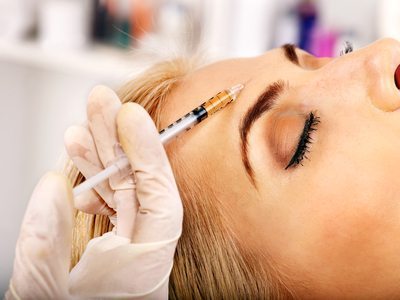Although Botox is used by millions of men and women each year, most people aren’t fully aware of its composition and range of uses. Since it was first introduced, skincare technicians and doctors have discovered that Botox offers a host of other benefits in addition to its most familiar claim to fame: softening and decreasing the appearance of lines and wrinkles. So today, we’re focusing on Botox 101: the composition of Botox, where you should receive a treatment, how Botox can be used, the benefits it offers, and the safety risks it can pose. Scroll down for a quick lesson in botulinum toxin (aka Botox).
Botox 101
What is Botox?
Botox is a drug created from various forms of botulinum toxin. Used in small doses, it can treat a number of physical concerns and health problems by weakening or paralyzing certain muscles and nerves.
Where should I receive a Botox treatment?
If you’re interested in Botox, it’s important to look for a quality service. Instead of receiving a Botox treatment spur-of-the-moment at the mall or a “Botox party,” look for a skilled and experienced skincare technician and be sure to have a consultation beforehand. At a medical setting, you can feel confident that the technician is using fresh Botox that has been stored correctly, as well as good hygiene and proper application techniques.
How can Botox be used and what benefits does it offer?
As most people know, Botox can be used to reduce the appearance of wrinkles. In some ways, it’s like an eraser, smudging the harsh lines that appear on our faces over time. However, it’s also beneficial for people suffering from migraines or hyperhidrosis (i.e., excessive sweat). Finally, it may help people struggling with bladder control, joint pain, and various eye issues (strabismus, diplopa, and blepharospasm). To learn more about the benefits of Botox, please check out this previous blog post.
What are the safety risks of Botox?
Botox is a very popular procedure. It has been used for over 30 years and when properly administered, there are very few safety concerns. However, before you receive Botox, your skincare technician should determine whether or not you’re a good candidate for the treatment. For example, if you have a muscle/nerve disorder, a Botox allergy, are pregnant or breastfeeding, or will soon be having surgery (amongst other situations), you may not be eligible for Botox.
As with all medical procedures, there are some side effects and potential complications to Botox as well. Side effects include redness, swelling, pain at the injection site, bruising, and bleeding. Your skin’s natural reaction, the technician’s skill, the size of the needle, and luck can all influence whether or not you will have these side effects. Complications aren’t common, but if you experience any strange symptoms, call your doctor immediately. Complications can include difficulty swallowing, difficulty breathing, blurred vision, drooping eyelids, and a change of voice.
If you’re interested in receiving Botox treatments and you live in Springfield, Missouri, contact DermaHealth. We use neurotoxins like Botox and Dysport to treat frown lines, bunny lines, crow’s feet, hyperhidrosis, and more. To learn more about our Botox treatments, please give us a call at 417-447-7777 or click here to schedule a free consultation. We look forward to hearing from you!







